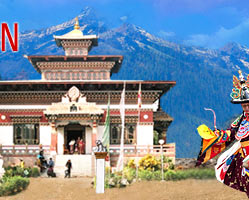Doma Pani, or areca nut and betel leaf with a dash of lime, has been a traditional addictive food of Bhutan for several years. Bhutanese love to chew upon the betel nut and ‘khamto’ or quid of Doma Pani after a sumptuous dinner. Doma is often referred to as ‘trozey’ or a conversation starter and is an integral part of Bhutanese culture and life style. Most of the aging Bhutanese, from all sections of society, are avid doma chewers. Doma is a traditional offering of Bhutan on all occasions including the annual observance of the auspicious Zhugdrel Phuensum Tshogpa ceremony. The history of how doma became such an important part of Bhutan is unknown. The earliest event ever recorded about doma is found in the description of the ceremony of Zhugdrel Phuensum Tshogpa, which refers to an elaborate meal hosted by Zhabdrung in 1637.
According to the Driglam Namzhag Manual published by the National Library in Thimphu, the meal was actually a huge gathering of people that came with all types of foods and drinks to pay their tributes and pledge their loyalty to the Zhabdrung in Punakha. Zhabdrung was so touched with the gesture of the people; he ordered that all of them should be served with choices foods including ‘droma (kaser), drizang (saffron fragrance), suja (butter tea), dresi (fried sweet rice), doma pani, and a variety of fruits’. In the ‘History of Bhutan’ by Lopon Padma Tshedwang, he mentioned that some early settlers of the Moen Yul were cannibals. They were tamed by the Buddhist spiritual leader Guru Rinpoche, who introduced a substitute to them that used Rushing (bark of Poikilospermum, a creeper plant) for raw flesh, Areca Nut for the bones, Betel Leaf for the skin and Lime for the brain. The red color that emerged from chewing this combination was to be the blood that these people used to drink.
However, in ‘The Tradition of Betel and Areca in Bhutan’ by Francoise Pommaret, he notes that none of the eminent visitors to Bhutan such as George Bogle in 1774, Samuel Turner in 1783, Kisan Kant Bose in 1815 and Pemberton in 1838, has ever mentioned Bhutanese chewing doma. Yet, some of them did mention that Bhutanese imported betel nut from Bengal and Assam. So, perhaps Bhutanese picked up the habit of doma chewing from the Assamese people in the course of centuries, when they visited them for trade or during their raids of the neighboring states. There was a time, when doma was the best and most popular gift that was expected a person, who visited India because betel leaves did not grow on the mountains. For a long time, the use of doma was restricted only to the aristocrats because it was a luxury, fit only for the rich people who could import it from the southern plains.
There was an elaborate tradition related to handling doma and people used to carry the nut and the leaf in a rectangular box called ‘chaka’ and lime in a separate circular box with conical lid called ‘trimi’. Chaka and Trimi were usually made of silver. People from royal families and noblemen used to carry Chaka and Trimi that were gold plated and adorned with intricate lotus motifs and designs. Today, many people catty doma in a cloth pouch known as ‘kaychung’. Aristrocats used to gift doma to the common people to honor them and especially, if the doma was offered from the ‘chaka-trimi’ of the important person, it was considered a matter of immense pride for the receiver. People who couldn’t afford doma, used rushing’s bark and gonra’s roots that were chopped and dried and chewed with a betel leaf. It also produced a red juice like doma pani.
But they are not used much anymore because now doma is easily available everywhere. They are now used as a rare ingredient to be added in small quantities with doma. If you are looking for a casual gift to a Bhutanese friend or offering to strangers, you can never go wrong with a doma. Mostly, doma is the first thing offered to a guest in Bhutan and doma chewing extends to all; despite their age, gender, status, time and place. However, the tradition and consumption of doma is on its decline in the younger generation. They find blood-red doma juice, spitted out but doma chewers everywhere, offensive too. Yet, doma is so embedded with Bhutanese religious and temporal spheres that it is indispensable to the culture.




